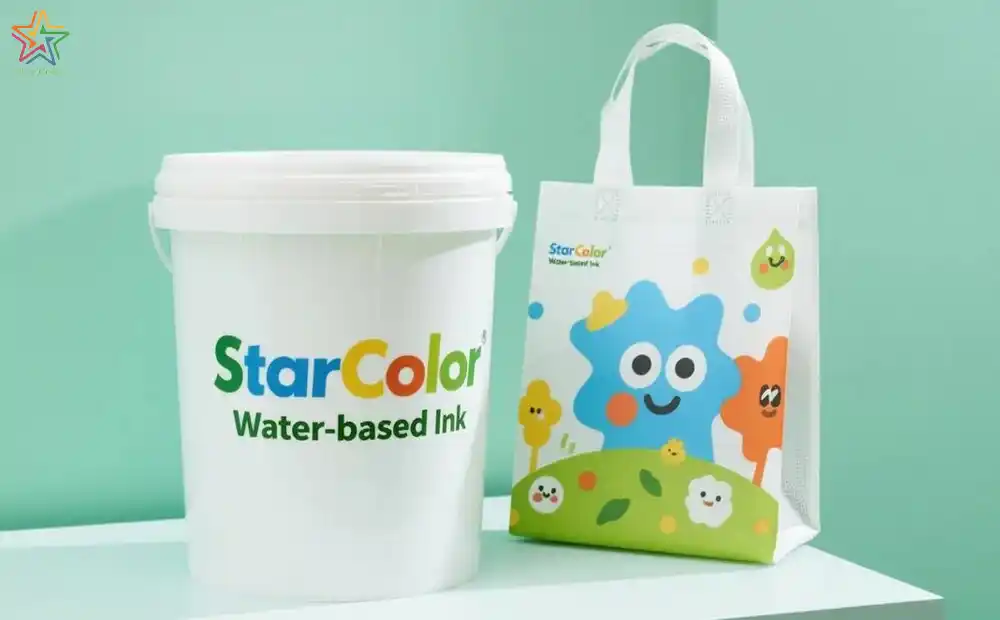As sustainability becomes a core value across industries, printers and manufacturers are seeking alternatives to traditional solvent-based inks. One of the most effective and eco-friendly solutions on the market today is aqueous ink—also known as water-based ink. But what exactly are aqueous inks, and why are they gaining popularity in commercial and industrial printing?
In this article, we’ll explore the definition, advantages, applications, and future trends of aqueous inks—and introduce how Starcolor is leading innovation in this space.
What Are Aqueous Inks?
Aqueous inks are a type of printing ink that uses water as the primary solvent or carrier, instead of petroleum-based chemicals. These inks typically contain:
Water (as the carrier)
Dyes or pigments (for color)
Binders/resins (for adhesion)
Additives (for flow, stability, and drying performance)
There are two main types of aqueous inks:
Dye-based: Known for bright, vivid colors but less water-resistant
Pigment-based: More durable and UV-resistant, ideal for outdoor or archival prints
Aqueous inks are commonly used in inkjet, flexographic, gravure, and textile printing, depending on the formulation.

Key Properties and How Aqueous Inks Work
Aqueous inks function by depositing colorants suspended in water onto a substrate. The water then evaporates or is absorbed into the material, leaving the colorant and resin behind. The ink film binds to the surface, resulting in a clean, vibrant, and stable image.
These inks require substrates that absorb moisture or special coatings to ensure proper adhesion and drying. In high-speed printing environments, forced air or heat is often used to accelerate drying.
Benefits of Aqueous Inks
🌱 1. Environmentally Friendly
Low VOC emissions: Aqueous inks emit little to no volatile organic compounds (VOCs), making them safer for operators and compliant with environmental regulations.
Non-toxic and biodegradable: Perfect for brands pursuing eco-labeling or green certifications.
🎨 2. Outstanding Print Quality
High color vibrancy and clarity
Smooth finishes with excellent dot definition and detail
Ideal for packaging, fine art, and premium commercial applications
🛡️ 3. Safe for Sensitive Applications
Suitable for food packaging, children’s products, and medical labels
Compliant with global safety standards
⚡ 4. Cost-Effective in the Long Term
Reduced need for solvent recovery systems
Lower maintenance costs for machinery
Extended printhead life in digital systems
Applications of Aqueous Inks
Aqueous inks are used in a wide variety of industries and substrates:
Paper & Board: Magazines, books, paper bags, corrugated boxes
Flexible Packaging: Pouches, films, and wrappers
Textiles: Direct-to-garment (DTG) and direct-to-film (DTF) printing
Labels & Stickers: Durable product labels, security tags
Art & Graphics: Posters, fine art reproduction, photo prints
Inkjet Printing: Commercial, industrial, and home printers
Aqueous Inks vs. Other Ink Technologies
| Feature | Aqueous Inks | Solvent-Based Inks | UV-Curable Inks |
|---|---|---|---|
| Carrier | Water | Organic solvents | UV-reactive compounds |
| VOC Emissions | Very low | High | None |
| Substrate Requirement | Absorbent or coated | Broad (uncoated ok) | Broad |
| Drying Mechanism | Evaporation/absorption | Fast solvent evaporation | UV light curing |
| Application Safety | Non-toxic | Hazardous vapors | Requires UV protection |
| Cost & Maintenance | Low to medium | Medium to high | Medium to high |
Challenges & Considerations
While aqueous inks offer many benefits, they do have limitations:
Limited adhesion on non-porous substrates (unless treated or coated)
Water resistance may require post-coating or lamination
Slower drying than UV or solvent in some conditions
Not suitable for high-moisture environments without enhancements
However, ongoing innovation—especially in binders and coating chemistry—is closing these gaps quickly.
Trends Driving Aqueous Ink Adoption
🌍 Growing demand for sustainable packaging and compostable materials
🏭 Increased use in industrial inkjet systems (e.g. corrugated, textiles)
🔬 Advances in high-performance resins improving durability and water resistance
💡 Support from global brands focused on ESG and green printing solutions
Why Choose Starcolor Aqueous Inks
At Starcolor, we specialize in premium aqueous inks engineered for both performance and sustainability. Here’s why our clients across the globe trust us:
✅ Advanced Formulation Technology
High pigment load with stable dispersion
Controlled drying and excellent adhesion on multiple substrates
✅ Industry-Tailored Solutions
Custom ink lines for packaging, textile, and label printing
Compatible with flexo, gravure, and inkjet systems
✅ Eco-Compliant and Safe
Low-VOC, heavy metal-free, and compliant with RoHS, REACH, and FDA (indirect contact)
✅ Field-Proven Results
Trusted by leading manufacturers in Asia, Europe, and North America
Optimized for high-speed, high-volume production
✅ Global Support Network
Fast delivery, multilingual technical support, and R&D customization available
Ready to Upgrade to Eco-Friendly Printing?
If you're looking for a reliable, high-performance alternative to solvent-based inks, Starcolor aqueous inks offer the perfect balance of quality, safety, and sustainability.
📞 Contact our team today for a free consultation or to request a sample.
🌐 Visit starcolor-ink.com to learn more.